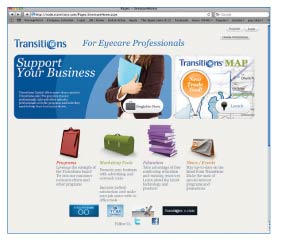 Wholesale lab Precision San Diego recently hosted an educational event to launch its new Digital Plus initiative. The event, which was attended by 60 select customers, was held at the uniquely designed Rotating Home in San Diego.
Wholesale lab Precision San Diego recently hosted an educational event to launch its new Digital Plus initiative. The event, which was attended by 60 select customers, was held at the uniquely designed Rotating Home in San Diego.
“We understand there is much confusion around digital lenses and when to recommend what design so we developed a series of tools to help the independent eyecare professional convey a clear and understandable presentation to their eyecare patients,” says Mark Becker, president and CEO of Precision San Diego. “We needed high graphic and easily understood images to convey the high definition message.”
To do this, Precision created a lens selection guide, a “Why High-Def?” brochure, simplified bundled pricing packages along with track and reward reports. Lunch and learn sessions are used to kick off the Digital Plus program for the interested eyecare professional.
“The characteristics of the rotating house helped illustrate the achievements that can occur when design and process are harmoniously blended. Eyecare professionals are rapidly learning the importance of prescribing new digital designed and produced lenses.” Becker concludes, “We felt that anything we could do to help them in their efforts would benefit the consumer experience and help us all.”
At the event, Dr. Rosina Monaco (second from left) and her staff enjoyed the view from the Rotating House.
The Rotating House is covered by 47 patents. It was featured in June 2011 on the TV show “HouseSmarts” and will be featured soon on MTV’s “Unique Cribs.” It has also been featured in over 50 magazines around the world, including San Diego Home and Garden, KiJi, Wired and Home Automation.
TRANSITIONS LAUNCHES MAP PROGRAM, OFFERING ECPS INFO ON LOCAL MARKETS
 Transitions Optical has unveiled a new program called MAP (Market Area Profile), designed to help eyecare professionals learn more about the demographics and economic climate of their local markets.
Transitions Optical has unveiled a new program called MAP (Market Area Profile), designed to help eyecare professionals learn more about the demographics and economic climate of their local markets.
“Many practices are aware that marketing is important, but they don’t necessarily have resources to tailor their programs to reach patients with the best revenue potential,” explains Dana Reid, Transitions’ senior marketing specialist-ECP communications. Since demographics such as ethnicity, age and lifestyle influence the amount and type of vision products and services consumers purchase, Reid says, “Understanding which target audiences are prominent in the area where they practice, and the opportunities associated, can help ECPs customize their outreach to these groups, which is a more effective way to reach them than a one-size-fits-all approach.”
The Transitions MAP program (available free through the company’s trade portal at www.Transitions.com/Pro) also links ECPs to other resources they can use to reach target audiences.
To navigate the new program, visitors enter their practice’s zip code, generating an interactive market-area map that outlines the geographic vicinity in which most of the practice’s current patients and potential new customers likely reside. Users can then access detailed descriptions of consumer segments on their market area by target audience, including information on demographic characteristics.
Data can also be obtained on the average amount spent on eyewear by zip code; information about the area’s competitive landscape can help practices fine-tune marketing tactics to stand out from the competition, according to the company.
A Transitions spokesperson says the MAP program “will keep evolving,” with additional functions being added as the tool develops.
—Andrew Karp











